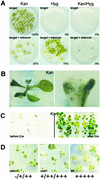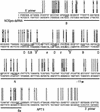RNA-directed DNA methylation in Arabidopsis
- PMID: 12169664
- PMCID: PMC139914
- DOI: 10.1073/pnas.162371499
RNA-directed DNA methylation in Arabidopsis
Abstract
In plants, double-stranded RNA that is processed to short RNAs approximately 21-24 nt in length can trigger two types of epigenetic gene silencing. Posttranscriptional gene silencing, which is related to RNA interference in animals and quelling in fungi, involves targeted elimination of homologous mRNA in the cytoplasm. RNA-directed DNA methylation involves de novo methylation of almost all cytosine residues within a region of RNA-DNA sequence identity. RNA-directed DNA methylation is presumed to be responsible for the methylation observed in protein coding regions of posttranscriptionally silenced genes. Moreover, a type of transcriptional gene silencing and de novo methylation of homologous promoters in trans can occur if a double-stranded RNA contains promoter sequences. Although RNA-directed DNA methylation has been described so far only in plants, there is increasing evidence that RNA can also target genome modifications in other organisms. To understand how RNA directs methylation to identical DNA sequences and how changes in chromatin configuration contribute to initiating or maintaining DNA methylation induced by RNA, a promoter double-stranded RNA-mediated transcriptional gene silencing system has been established in Arabidopsis. A genetic analysis of this system is helping to unravel the relationships among RNA signals, DNA methylation, and chromatin structure.
Figures






References
Publication types
MeSH terms
Substances
LinkOut - more resources
Full Text Sources
Other Literature Sources
Research Materials

